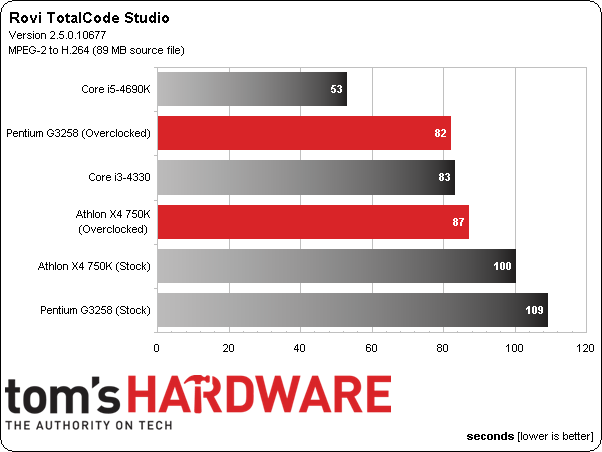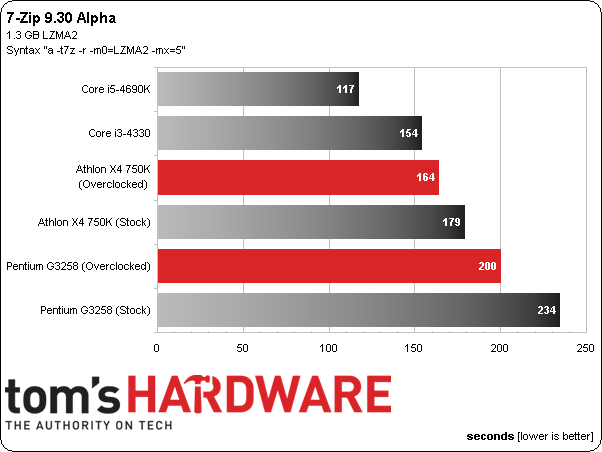The Pentium G3258 Cheap Overclocking Experiment
You wanted a comparison of Intel's Pentium G3258 using low-cost platform components. Can an entry-level motherboard and bundled heat sink still deliver a satisfying overclocking experience, or does going cheap ruin this dual-core CPU's value appeal?
Results: Real-World Benchmarks
Content Creation



I should probably preface the next several paragraphs with a caveat: nobody who runs taxing workloads is going to settle for a dual-core Pentium (or even a Core i3/Athlon). If you read my Core i7-4790K review, you know that even a still-mainstream Core i7 can finish our workloads in half the time of what’s reflected here.
Nevertheless, it’s remarkable that Intel’s Pentium G3258 jumps from last place to second with a 1.2 GHz tailwind in 3ds Max. Similarly, AMD’s Athlon X4 750K hops ahead of the pricier (and multiplier-locked) Core i3-4330 after a 900 MHz overclock.
The finishing order doesn’t really change in Blender, nor is Vegas Pro 12’s outcome affected.
Adobe CC



AMD’s Athlon X4 750K overclocked to 4.3 GHz loses a little steam on our new platform in Premiere Pro CC. Still, a higher frequency shaves off more than a minute from its render time.
After Effects is the first title seriously affected by this experiment. Intel’s Pentium runs quite a bit slower, barely beating the stock G3258, while the Athlon seriously regresses. But the explanation is simple enough. Both low-cost motherboards come equipped with two memory slots, cutting us back from 16 to 8 GB of DDR3 RAM. Our After Effects workload is acutely sensitive to available memory per core or thread, which is why performance tanks.
It pops back up in Photoshop, though. The Pentium doesn’t change much. AMD’s Athlon slows down a little, allowing the Core i3 to pass. More interesting is how the Piledriver architecture seems to hold our GeForce GTX Titan back in the OpenCL-accelerated test. Overclocking doesn’t really help alleviate that bottleneck either.
Productivity and Media Encoding






While the Pentium G3258 doesn’t slow down much in FineReader, despite losing 100 MHz of overclocked frequency at the hands of a too-small stock cooler, AMD’s Athlon X4 750K runs about 10 seconds longer in this benchmark. That puts the quad-core processor behind Intel’s dual-core chip.
Get Tom's Hardware's best news and in-depth reviews, straight to your inbox.
Visual Studio shows the Athlon performing much more consistently—it nearly ties its previous result. Intel’s Pentium lands just ahead of it, and neither CPU is able to catch a dual-core, Hyper-Threaded Core i3-4330.
The finishing order stays pretty consistent in TotalCode Studio, while the overclocked Athlon moves down a spot in HandBrake. Practically, though, we’d call that a tie with Intel’s more expensive Core i3-4330.
LAME and iTunes are both single-threaded metrics, exercising one core on each CPU. With clock rate and instruction per cycle throughout in the spotlight, an overclocked Haswell-based processor naturally wins. The Piledriver design just can’t keep up, even running at 4.3 GHz.
Compression



Our WinZip benchmark includes three workloads. Sorted by threaded CPU scores, AMD’s Athlon X4 overclocked beyond 4 GHz scores a victory against Intel’s Pentium G3258. In the maximum-compression EZ and OpenCL-accelerated tests, the tables turn.
The finishing order doesn’t change in WinRAR or 7-Zip. The former favors Intel’s Haswell architecture and doesn’t really reward highly parallel configurations, while the latter knows how to exploit AMD’s module-oriented design for maximum performance from four integer units.
Current page: Results: Real-World Benchmarks
Prev Page Results: Synthetics Next Page Performance, Price and Value-
Someone Somewhere First page (in bold heading):Reply
Wait, Did You Say B81?
You mean either H81 or B85, I'm guessing. -
vertexx Are you seriously running the Athlon on DDR3-1600 RAM? Please confirm as it's too difficult to be sure with all of the ridiculous adware you have baked into this article.Reply -
LucoTF Reply13828161 said:First page (in bold heading):
Wait, Did You Say B81?
You mean either H81 or B85, I'm guessing.
LOL
they were offered both and settled on the H81 -
tomfreak U guys should throw in Core 2 quad 9550/9650 and bench together or even the Nehelem quad core to compare.Reply -
cangelini @ Nuckles_56: the modules we used came from one standardized kit. Because the H81 and A78 platforms only offer two slots, we pulled two modules from the kit. The other boards gave us four slots, so we used four modules from the same kit. On an X79- based board, you'd see all eight in play.Reply -
Traciatim @TomFreak, Tom's have already done an old vs new article that tested the core2duo and Quad vs newer i3's an i5's. No reason to redo the tests since you can pretty much extrapolate about where your performance would sit if you look over both articles. Bottom line is it's probably not worth going from a Core2Quad that overclocks pretty reliably to an i3 or Pentium, but in most cases the i3 and newest unclocked Pentium would perform slightly better and use less power.Reply
http://www.tomshardware.com/reviews/ivy-bridge-wolfdale-yorkfield-comparison,3487-9.html
-
bdiddytampa If you are in the US and are close to a Microcenter, they offer a G3258 and MSI Z97 board bundle for $99. Killer deal for a cheap starter system.Reply
